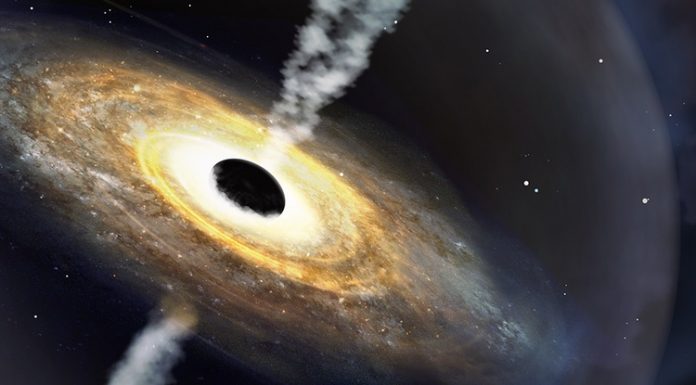Astronomers have discovered the second-most distant quasar ever found using three Maunakea Observatories in Hawai’i: W. M. Keck Observatory, the international Gemini Observatory, a Program of NSF’s NOIRLab, and the University of Hawai’i-owned United Kingdom Infrared Telescope (UKIRT). It is the first quasar to receive an indigenous Hawaiian name, Poniua’ena, which means “unseen spinning source of creation, surrounded with brilliance” in the Hawaiian language.
Poniua’ena is only the second quasar yet detected at a distance calculated at a cosmological redshift greater than 7.5 and it hosts a black hole twice as large as the other quasar known in the same era. The existence of these massive black holes at such early times challenges current theories of how supermassive black holes formed and grew in the young universe.
The research has been accepted in the Astrophysical Journal Letters.
Quasars are the most energetic objects in the universe powered by their supermassive black holes and since their discovery, astronomers have been keen to determine when they first appeared in our cosmic history. By systematically searching for these rare objects in wide-area sky surveys, astronomers discovered the most distant quasar (named J1342+0928) in 2018 and now the second-most distant, Poniua’ena (or J1007+2115, at redshift 7.515). The light seen from Poniua’ena traveled through space for over 13 billion years since leaving the quasar just 700 million years after the Big Bang.
Spectroscopic observations from Keck Observatory and Gemini Observatory show the supermassive black hole powering Poniua’ena is 1.5 billion times more massive than our Sun.
Poniua’ena is the most distant object known in the universe hosting a black hole exceeding one billion solar masses,” said Jinyi Yang, a postdoctoral research associate at the Steward Observatory of the University of Arizona and lead author of the study.
For a black hole of this size to form this early in the universe, it would need to start as a 10,000 solar mass “seed” black hole about 100 million years after the Big Bang, rather than growing from a much smaller black hole formed by the collapse of a single star.
“How can the universe produce such a massive black hole so early in its history?” said Xiaohui Fan, Regents’ professor and associate department head of the Department of Astronomy at the University of Arizona. “This discovery presents the biggest challenge yet for the theory of black hole formation and growth in the early universe.”
Current theory holds the birth of stars and galaxies as we know them started during the Epoch of Reionization, beginning about 400 million years after the Big Bang. The growth of the first giant black holes is thought to have occurred during that same era in the universe’s history.
The discovery of quasars like Poniua’ena, deep into the reionization epoch, is a big step towards understanding this process of reionization and the formation of early supermassive black holes and massive galaxies. Poniua’ena has placed new and important constraints on the evolution of the matter between galaxies (intergalactic medium) in the reionization epoch.
“Poniua’ena acts like a cosmic lighthouse. As its light travels the long journey towards Earth, its spectrum is altered by diffuse gas in the intergalactic medium which allowed us to pinpoint when the Epoch of Reionization occurred,” said co-author Joseph Hennawi, a professor in the Department of Physics at the University of California, Santa Barbara.
METHODOLOGY
Yang’s team first detected Poniua’ena as a possible quasar after combing through large area surveys such as the UKIRT Hemisphere Survey and data from the University of Hawai’i Institute for Astronomy’s Pan-STARRS1 telescope on the Island of Maui.
In 2019, the researchers observed the object using Gemini Observatory’s GNIRS instrument as well as Keck Observatory’s Near Infrared Echellette Spectrograph (NIRES) to confirm the existence of Poniua’ena.
“The preliminary data from Gemini suggested this was likely to be an important discovery. Our team had observing time scheduled at Keck just a few weeks later, perfectly timed to observe the new quasar using Keck’s NIRES spectrograph in order to confirm its extremely high redshift and measure the mass of its black hole,” said co-author Aaron Barth, a professor in the Department of Physics and Astronomy at the University of California, Irvine.
Story Source:
Materials provided by W. M. Keck Observatory. Note: Content may be edited for style and length.















